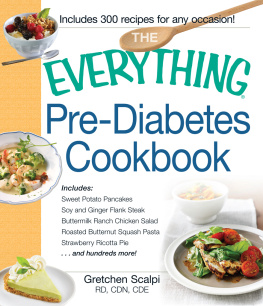THE

PRE-DIABETES COOKBOOK
Gretchen Scalpi, RD, CDN, CDE

Avon, Massachusetts
To all of my clients with pre-diabetes who have reaped the rewards of a healthy lifestyle that includes eating well!
Contents
Introduction
If you are reading THIS COOKBOOK, odds are that you have concerns about the fact that you or a loved one has pre-diabetes. Once diagnosed with pre-diabetes most people realize that they need to do something to take control of the situation.
Managing pre-diabetes means understanding what it is and what to do about it. The more you understand, the better you can take action to reverse it or minimize your risk of developing type 2 diabetes. Luckily, by reading and using this cookbook you can get ideas to put into practice right now. You will have taken the first steps toward learning about managing and reversing pre-diabetes.
In order to understand pre-diabetes, its helpful to know more about diabetes. This quick overview will help you to see the connection to prediabetes and why action on your part should not be delayed.
Diabetes Mellitus
Every time you eat, your body converts the foods you consume into glucose (sugar). Insulin is a hormone the body makes that enables the glucose to get into cells, where the glucose is used for energy. People with diabetes either lack sufficient amounts of insulin or are unable to use the insulin they make. When insulin is absent or ineffective, the body is unable to get energy into cells and the level of glucose in the blood increases. To put it simply, your blood sugar level is too high. Genetics, obesity, and lack of exercise appear to be factors in most cases of diabetes. There are also several different types of diabetes.
Type 1 Diabetes
Approximately 510 percent of known cases of diabetes are classified as type 1 diabetes. Type 1 diabetes was formerly referred to as juvenile-onset diabetes because the onset typically occurs before the age of thirty. Type 1 diabetes is an autoimmune disorder that is thought to develop when stress factors (such as a viral infection) damage or destroy the beta cells of the pancreas. The person with type 1 diabetes is always dependent upon insulin because her pancreas no longer produces insulin. Type 1 diabetes is usually not associated with obesity or lack of exercise. Our discussion of prediabetes in this cookbook is mostly focused on type 2 diabetes rather than type 1 diabetes.
Type 2 Diabetes
The vast majority of individuals who have diabetes have type 2 diabetes. For most people with type 2 diabetes, the pancreas still produces insulin, but it is being produced in insufficient amounts, or the body simply is unable to use the insulin in an efficient way.
Most people with type 2 diabetes are diagnosed in mid- to late adulthood. Unfortunately, with the growing prevalence of obesity among children, we are now seeing children and young adults with type 2 diabetes as well.
Type 2 diabetes is often related to a sedentary lifestyle and an overweight or obese status. It is important to understand that diabetes is a disease that will progress, and while it can be controlled, it cannot be cured. Over time many people with type 2 diabetes may require oral medications and/or insulin injections to effectively treat and manage the disease. If untreated, a person with pre-diabetes may go on to develop type 2 diabetes.
Gestational Diabetes
Gestational diabetes is similar to type 2 diabetes because the body still makes insulin; however, a hormone secreted by the placenta interferes with the action of insulin. The result is elevated blood glucose levels usually starting between the twenty-fourth and twenty-eighth weeks of the pregnancy. In most cases, a pregnant womans blood glucose returns to normal after the delivery of the baby and the diabetes is gone. A woman who has had gestational diabetes in the past has an increased risk of developing type 2 diabetes at a later time in her life, especially if she remains overweight or sedentary.
Seven Self-Care Behaviors
Managing diabetes and pre-diabetes is all about making lifestyle changes. The American Association of Diabetes Educators (AADE) believes that utilizing principles of the 7 Self-Care Behaviors is an effective way to make positive changes in lifestyle. The following self-care behaviors apply to those with pre-diabetes and diabetes:
THE 7 SELF-CARE BEHAVIORS
- Healthy Eating: Make healthy food choices, understand portion sizes, and learn the best times to eat.
- Being Active: Include regular activity for overall fitness, weight management, and blood glucose control.
- Monitoring: Self-monitor blood glucose to assess how food, physical activity, and medications are working.
- Taking Medication: Understand how prescribed medications work and when to take them.
- Problem-Solving: Learn how to problem-solve. A high or low blood glucose episode requires the ability to make a quick decision about food, activity, or medication.
- Reducing Risks: Develop behaviors that reduce risk. Smoking cessation and regular eye exams are examples of self-care that reduces risk of complications.
- Healthy Coping: Develop good coping skills to deal with the challenges of diabetes and stay motivated to keep diabetes in control.
As you read this cookbook, you will find practical tools to empower you to learn about a healthier way of preparing and eating food. Taking control means having an action plan that you can live with! With practical tools and an effective plan, you have been given an opportunity to prevent or delay the onset of type 2 diabetes. Take it!
CHAPTER 1
Managing and Reversing Pre-Diabetes
Your doctor has just told you that you or your loved one has pre-diabetes. Your initial reactions might have been shock, anger, or a feeling of helplessness. Perhaps you knew something was not quite right all along, but you tried to put the whole thing out of your mind. Whatever the case, you are now faced with a medical diagnosis that has the potential to be serious. Many people in this situation do not know what pre-diabetes means or what to do about it. You can start by learning more about pre-diabetes and taking steps to stop pre-diabetes in its tracks.
What Is Pre-Diabetes?
The most recent data from the National Diabetes Fact Sheet, 2011, put out by the Centers for Disease Control and Prevention (CDC), estimates that there are 79 million Americans with pre-diabetes. Yes, you read that correctly: 79 million Americans! The numbers are growing annually; in large part because pre-diabetes is linked to Americas other serious health problems: overweight and obesity. Being overweight and having elevated blood sugar tend to go hand in hand. Blood sugar that fluctuates too high or too low throughout the day has a direct influence on your hunger level and snacking habits. If your blood sugar is too low, you may eat too much food. If you eat too much food, over time you gain weight. Weight gain sets the stage for developing pre-diabetes, or worse yet, diabetes.











